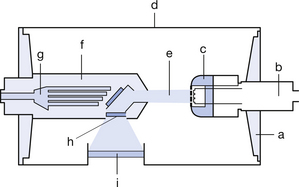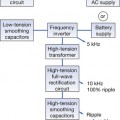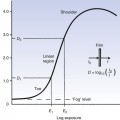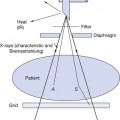Chapter 32 Orthovoltage generators and linear accelerators
32.1 Aim
The aim of this chapter is to review the main differences between diagnostic X-ray generators and the orthovolvoltage generator. It will also present an overview of the linear accelerator.
32.2 Introduction
1. Superficial therapy using energies of up to 150 kV with beam filtration of 1–8-mm aluminium equivalent material at a focus to skin distance (FSD) of 10–30 cm.
2. Orthovoltage or ‘deep’ therapy with energies of 150–500 kV with 0.5–3-mm copper filtration at a 50-cm FSD.
32.3 The orthovoltage unit
There are a number of similarities and differences between these units and the general diagnostic unit. The orthovoltage unit uses a stationary anode X-ray tube, unlike the rotating anode used in diagnostic radiography. The circuit of a high voltage generator is similar to that of modern microprocessor-controlled medium-frequency diagnostic generators (see Ch. 28). However, the control panel differs in that a number of distinct stages must be followed in sequence before exposure can be initiated; these include the ability to select the additional filtration used – this automatically sets the kV and mA available. The radiographer must then select the dose to be delivered and the exposure time. This determines the setting of the back-up timer, which will terminate the exposure if the elapsed time exceeds the set time by 10%. Other differences are the beam filtration and the way in which the beam is collimated.
32.3.1 The X-ray tube
Unlike the rotating anode design found in diagnostic units, the orthovoltage unit uses a hooded stationary anode (see Fig. 32.1). This is likely to have an insert with a metal–ceramic envelope, which overcomes the common cause of tube failure, which in these units is usually the breakdown of the glass envelope around the insert. As can be seen, the target is surrounded by shielding apart from two ports: the first is in line with the electron beam from the cathode, and the second, covered by a beryllium window, is at 90° to this axis and in line with the tube exit port. This permits the beam of useful radiation to leave the anode and tube. The hood serves two functions: i) it absorbs secondary electrons produced by electron interaction with the target; and ii) it attenuates unwanted radiation, reducing the thickness of the lead required in the tube housing, thus reducing weight of the tube assembly. Note that the anode, which loses heat through conduction to the oil surrounding the insert, has, in addition to a large cross-sectional area, channels in it through which oil is circulated, thus improving the cooling process.









